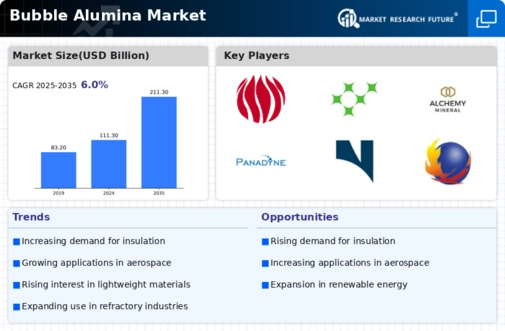Market Trends
Key Emerging Trends in the Bubble Alumina Market
The bubble alumina market is witnessing significant trends that are reshaping its landscape and driving growth across various industries. One significant trend is the increasing demand for bubble alumina in the refractories industry. Bubble alumina, known for its high temperature resistance, low thermal conductivity, and lightweight properties, is widely used in refractory applications such as furnace linings, kiln furniture, and insulation materials. With the growing demand for durable and efficient refractory solutions in industries such as steel, glass, and ceramics, the demand for high-quality bubble alumina is on the rise. Moreover, advancements in manufacturing processes and the development of advanced bubble alumina formulations are driving its adoption in refractory applications, further fueling market growth in the refractories industry.
Additionally, there is a growing trend towards the use of bubble alumina in the aerospace and automotive sectors. Bubble alumina is utilized in aerospace and automotive applications such as thermal barrier coatings, insulating materials, and lightweight structural components due to its high temperature resistance, thermal stability, and low density properties. With increasing demand for lightweight materials, improved fuel efficiency, and enhanced performance in aerospace and automotive applications, the demand for high-quality bubble alumina is increasing. Moreover, advancements in material science and engineering design are driving the development of bubble alumina-based materials with tailored properties and functionalities for specific aerospace and automotive applications, further driving market growth in these sectors.
Furthermore, there is a growing trend towards the use of bubble alumina in the electronics and electrical industries. Bubble alumina is utilized in electronics and electrical applications such as substrates, insulating materials, and thermal management components due to its high thermal conductivity, electrical insulation, and mechanical strength properties. With increasing demand for high-performance electronic devices, power modules, and LED lighting systems, the demand for high-quality bubble alumina is on the rise in the electronics and electrical industries. Moreover, advancements in material processing technologies and the development of advanced bubble alumina formulations are driving its adoption in electronic and electrical applications, further fueling market growth in these sectors.
Moreover, technological advancements and innovations are driving the growth of the bubble alumina market. Manufacturers are investing in research and development to develop advanced bubble alumina formulations, manufacturing processes, and application methods that offer improved performance, durability, and cost-effectiveness. Moreover, advancements in material characterization, processing techniques, and surface treatments are enabling the production of bubble alumina with tailored properties and functionalities for specific applications. Additionally, innovations in bubble alumina-based composites and hybrid materials are expanding the scope of its usage in new and emerging industries, further driving market growth.
Additionally, there is a growing trend towards customization and value-added services in the bubble alumina market. Customers are increasingly seeking bubble alumina solutions tailored to their specific application requirements, such as custom particle sizes, shapes, and purities. In response, manufacturers are offering comprehensive engineering support, design services, and customization options to meet diverse customer needs effectively. Moreover, value-added services such as testing, validation, and aftermarket support are becoming increasingly important as customers seek reliable and responsive suppliers for their bubble alumina requirements.











Leave a Comment